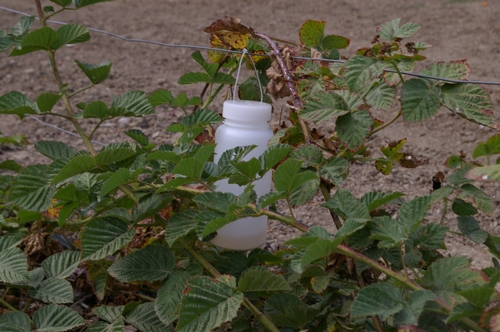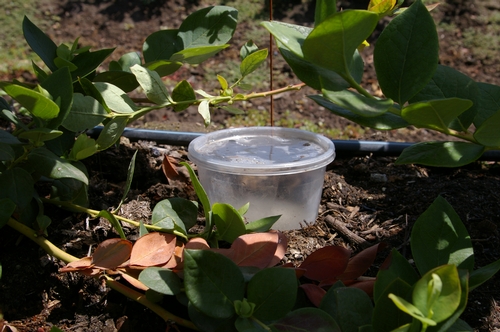
Posts Tagged: spotted wing drosophila
Monitoring spotted wing drosophila in Ventura County blueberries – June update
Today Ventura County Cooperative Extension Staff Research Associate Maren Mochizuki shares with us local SWD research results for the month of June.
For the month of June, we have detected an average of 1-2 individual spotted wing drosophila (SWD) per week (evenly split between males and females) at two of the three locations (Fig. 1). SWD was trapped in raspberries adjacent to these two locations in mid-April.
Graphed data summarizing the trapping results is shown below. More information about local SWD research can be found here (make link to SWD local research posts)

Fig. 1. Total number of spotted wing drosophila trapped
in blueberries at three Ventura Co. locations during June 2010.
For more information about this pest, please read previous posts or visit UC ANR’s intergrated pest management website.

Bucket-style trap under blueberry canopy.
Monitoring spotted wing drosophila in Ventura County – procedure
Today Ventura County Cooperative Extension Staff Research Associate Maren Mochizuki shares with us procedures used while conducting local spotted wing drosophila research. The procedures for successful research require planning, organization and devoted attention to detail.
About 3 days before each trapping period, we prepare fresh bait -- a solution of yeast, sugar, and water. After letting the bait rest for 24-48 hours (Mark Bolda, Strawberry and Caneberry Advisor in Santa Cruz, San Benito, and Monterey counties speculates the flies are attracted to the fermentation smell), we add it to the traps in the field. The next day, we check the contents of the trap and then dispose of the used bait offsite.
Another monitoring technique we utilize is sweep netting. For this project, we sweep the net back and forth along about 20 linear feet of blueberry shrubs, strawberry plants, or blackberry canes and then the contents are dumped over a container of soapy water to look at any flying insects that were caught.
We have been trapping weekly since the beginning of June in blueberries in Oxnard and Camarillo and added a mixed garden location in Santa Paula in early July.
For more information about this pest, please read previous posts or visit UC ANR’s intergrated pest management website.

Bottle-style trap used in caneberries and trees.

Bucket-style trap used in low-growing
plants such as blueberries and strawberries.
Monitoring spotted wing drosophila in Ventura County – site considerations
Today Ventura County Cooperative Extension Staff Research Associate Maren Mochizuki shares with us site considerations for local spotted wing drosophila research. As you will see much preparation, thought and cooperation is involved in research planning.
Because we are interested in the movement of spotted wing drosophila to/from host crops, we selected locations with one or more host crops (e.g. blueberries, raspberries, strawberries) adjacent to one another. Growers are very cooperative in allowing us monitor on their properties every week.
In early June, we installed traps in Oxnard and Camarillo (blueberries next to strawberries, blueberries next to raspberries and blueberries next to blueberries). In July, we added one location in Santa Paula (blackberries adjacent to nectarines, peaches, plums, apples and strawberries).
For this monitoring project, we had several considerations for trap locations:
1) Proximity to host crops. For example, for a blueberry field with strawberries on its north and west sides, we installed two traps each along those two edges but none to the south and east.
2) Crop cultural practices and maintenance. Normal activities in the field such as harvesting and watering adjacent farm roads to keep dust down (thanks to the grower who reminded us of this) could disrupt the traps. We tried to place them securely and several feet away from roads.
3) Wind direction. Because insects can be carried by wind, they may first appear in downwind areas.
4) Shading. Traps were placed in the shade of the plant canopy and partially buried in the case of blueberries or strawberries or hung under the canopy in the case of nectarines and blackberries to maintain a cooler bait temperature.
5) Replication. Multiple traps at the same property provide a more thorough survey.
For more information about this pest, please read previous posts or visit UC ANR’s intergrated pest management website.

Blueberries adjacent to strawberries in Ventura County.
Spotted wing drosophila
Spotted wing drosophila (previously known as the cherry vinegar fruit fly) is an invasive species that was first spotted in California in August 2008 in Santa Cruz County. It can now be found all throughout California and further north to Canada and arrived in our area late last spring. It has been found on a variety of commercial and backyard host crops including: cherry, raspberry, blackberry, blueberry, strawberry, boysenberry, varieties of Japanese plums, plumcots, and nectarines.
The spotted wing drosophila (SWD) is native to Southeast Asia. It lays its eggs in fresh soft fruit underneath the skin. The larvae hatch and then burrow inside the fruit to continue their development. In the earliest stage of infestation there is virtually no visible signs of damage to fruit. This pest has the potential to create severe economic losses for commercial growers and a loss of produce at home and community gardens.
Much work is being done by UC researchers throughout the state to find safe and effective ways to combat this insect. Monitoring is being conducted in Ventura County by Farm Advisors Oleg Daugovish and Ben Faber, Research Associate Maren Mochizuki, and Lab Assistant Marjie Bartels.
What can you do? Stay informed. Up-to-date information regarding this pest can be found on the UCR Center for Invasive Species Research website .
A prior version of this post incorrectly stated SWD had been found in apples and pears. There have been no reports of damage to these fruits in California or Oregon. For further information, please refer to this UC IPM page.
Spotted wing drosophilia update
As previously mentioned on our blog, the spotted wing drosophilia (formerly known as the cherry vinegar fly) has caused much damage to fruit in some California counties, including ours. UCCE scientists have worked hard since its arrival to find ways to minimize the damage to crops.
A UC Pest Management Guidelines publication for the spotted wing drosophila has recently been released. It can be downloaded for free. Other free UC Pest Management publications, arranged by crops, can be found here. Free pest information for homeowners and natural environments can be found at UC’s IPM home page.
